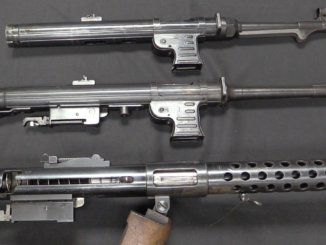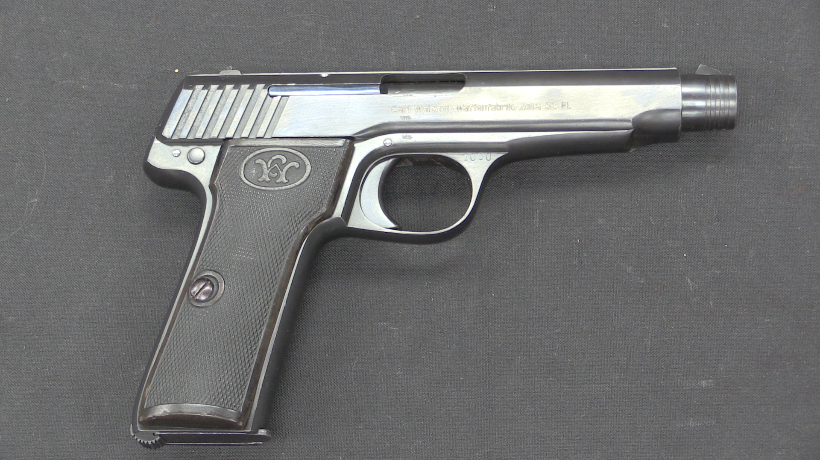Before World War One, the Mauser company tried to make a follow-up automatic pistol to replace its famous C96 “Broomhandle” design with something more modern. The result was a very successful pocket pistol in .25ACP and .32ACP, and a series of unsuccessful blowback and delayed blowback service pistols in 9mm and .45ACP. This particular one is an intermediate example, with an internal delayed blowback system and buffer spring, but before the designers turned to a flap-style system to delay the action.
Related Articles

Submachine Guns
The Schmeisser MP41: A Hybrid Submachine Gun
Most people think that the MP41 is simply an MP40 in a wooden stock, but this is actually not the case – and unlike the MP40, the MP41 can be accurately called a Schmeisser – […]

Submachine Guns
Vintage Saturday: Overkill
The German has a rather uncommon Erma MP-35, and judging from the can the unfortunate fellow in the grass was carrying magazines for a DP-28.

Semiauto pistol
RIA: Walther Model 6 (Video)
Wather introduced its first pistol in 1908, creatively named the Model 1. With the outbreak of World War One, the company was offering the Model 4 pistol for military use. This was a .32 ACP […]

As stated, the 9mms were definitively more numerous than the .45s. Ezell (HOTW, pp.401-409) states that “a few hundred” were sold to Brazil, most with shoulder stocks, and has photos of two, S/N 129 and 147, respectively.
He also shows S/N 4, 9mm, field-stripped; it has the twin locking wedges and the “disconnect” lever at the front of the trigger-guard, but does not have the twin “bulges” in the forward frame. They may have been added initially to increase web thickness and reduce the chances of frame cracking at that high-stress point.
Incidentally, S/N 147 has the name “C.Erskine Gray” engraved in its removable sideplate. Exactly who this was, I don’t know, but I suspect it might have been a previous owner of the pistol. (The photo came courtesy of Vaclav “Jack” Krcma, if that’s any help.)
cheers
eon
That delay mechanism looks like it would be subject to wear and become more unreliable over time. I don’t think they could have really made this work well.
Paul Mauser did lose an eye when a prototype rifle’s bolt broke the locking lugs… I downloaded a scan of the American patent for the rifle in question. The point of all of this blind alley business is probably that any pistol cartridge too powerful for “get your mitts off me” range will require a system where the slide or bolt-carrier disengages by Browning tilting method, vertical sliding locking block method, Krnka and Steyr rotating barrel method, or if you don’t want the barrel to move linearly, use the French MAB PA-15 with Savage rotating barrel delayed-blowback…
Suppose I modified this pistol to have a linearly sliding barrel and flap-locking mechanism. Would it work? Or would it need to change to something else? Please respond if you have any better ideas!!
Flap locks, roller locks, and the Walther P.38 type “wing lock” all have the same problem. That being that unless the slide and/or forward frame is very heftily built (H&K P9 series), and of very good materials, it will eventually fracture at the locking recesses. Generally at under 10,000 rounds, which is a lot for a civilian-owned pistol, but is defined as about three years’ use in normal practice, etc., for a police or military sidearm.
Recently, the U.S. Army began yet another search for a new standard service pistol due to serious durability problems with the Beretta M9 series. The slides fail at the locking recesses, the barrels fail at the locking block, and the frames crack at the locking block housing. Usually rendering the pistol unsafe at about 10,000 to 15,000 rounds. The front-runner to replace the M9 is the Glock 9mm, but some in AMC are leery of its polymer frame, which may not necessarily react to the climate in the Fertile Crescent the same way it does to that in the NATO countries.
The one thing everyone agrees on is that its locking system (the C. Petter variant of the Browning system, first introduced on the French M1935S service pistol in 1938) is a lot more durable than the M9’s lockup.
BTW, units that can “obtain” replacement pistols (mainly SpecOps) tend to go with M1911 variants, mainly in .45 ACP, and/or FN P-35 variants mostly in 9 x 19mm. All with steel frames.
Yes, they’re “primitive” by 21st Century standards, but they work and will keep on shooting long after the “advanced” sidearms are ready for recycling.
My guess is that 300 years from now, when StarFleet issues phasers made from the most advanced materials 23rd Century science can offer, the Fleet Marine Force will still have at least some all-steel 1911 clones in their armory- just in case.
cheers
eon
If not precisely and purposedly hand crafted, multi surface locks do not work all in at once in the same time. Walther P38, Cz 52, experimental flap locks and similar actions have all double side locking surfaces which only one side will work in practice. That working side, carrying the whole recoil load over a rather small area, will force the only one side of slide counter recess through fired rounds and eventually goes fructured or cracked. This rule is also present on the multi lug Browning tilted barrel locks. There is only one lug that works and others will wait their turn through the working surface to be peened by recoil shocks via the fact that, with descending surfaces since peening will not swage the counter recess only to backside but to the downside as well. Current M35S type ejection port engagements are most reliable samples of tilted barrel actions and rotating barrel types are much more reliable by cause of friction surfaces change through the unlocking stages. Besides, at tilted barrel locks, the distance from the working locking lug to camming element is also very important and effective since the barrel is forced to bend by leverage. The closer cam to lug distance, the safer the future barrel life and Russian Grach pistol is a good example for this approach.
Mauser 12/14 examples are all fixed barrel kinds and both delay and inertial actions should be experienced for the sake of not sacrificing this attractive feature but, with the application of actuating a slide release lever for manually retracting the slide which should not be an attractive feature for a service pistol. They all seem rather complicated for intended field and battle use.
With tilting and rotating barrel mechanisms each side of the locking system is typically machined all in one piece in one operation with one cutter.
With flappers, rollers, or other bits and pieces, there are more parts, each of which has its own tolerances. These tolerances stack up, producing greater error and therefore gaps. With a rifle or machine gun you can reinforce critical areas to strengthen them, but there’s less weight and size margin available for this with pistols.
Quality must be designed into a product, it can’t be inspected in afterwards. Craftsmanship or QC inspection are not a substitute for a good design.
“Recently, the U.S. Army began yet another search for a new standard service pistol due to serious durability problems with the Beretta M9 series. The slides fail at the locking recesses, the barrels fail at the locking block, and the frames crack at the locking block housing.”
Now the question is: which is defective: design or manufacturing process?
“The one thing everyone agrees on is that its locking system (the C. Petter variant of the Browning system, first introduced on the French M1935S service pistol in 1938) is a lot more durable than the M9′s lockup.”
For example Swiss SIG P210 produced from 1949 is still used by Danish Military, where is known as “Neuhausen pistol” what indicate that it doesn’t have any reliability issues.
Neither, really. Rather the US Army has increased its expectations. The durability of the standard M9 has been the same all the time, but the increased use of pistols in Iraq and Afghanistan has convinced the US Army that a more durable pistol than the M9 is required. To me, 3,000+ rounds per year still sound a lot of rounds fired for a pistol, even with training included.
Beretta already offered them the M9A3 to replace the M9 for the rest of the still undelivered old contracts, but the proposition was not accepted, probably because someone wants the M9 replaced as soon as possible, and introducing an improved version might jeopardize that goal. Official reason was that the changes to the M9A3 go to far for the scope of the Engineering Change Proposal (ECP) process.
My prediction is that in the end the US Army will keep the current M9 for several more years, because the new pistol will go nowhere in the end and accepting the M9A3 after it was already rejected once is unlikely… That’s just how the US Army procurement works (or rather doesn’t).
Sources:
http://www.beretta.com/en-us/m9a3/
http://www.armytimes.com/story/military/tech/2015/02/11/army-declines-m9a3-upgrade/23243689/
@Daweo and Euroweasel
Leave it to stupid bureaucrats to foul things up for the guys on the ground. The original Beretta magazines worked well in desert but the “sand proof” army magazines jammed the M9 like no tomorrow. Why do some people have nothing better to do than to take a good design and mess with it and then not bother testing what they just did?
Recommendation: after all the M9s are used up, please use something along the lines of a Browning action pistol if you really have to go with durability.
If I try reintroducing Krnka action but with detachable magazine, what would happen?
There are plenty of reliable semiauto pistols available “off the shelf” right now, even in .45 ACP (no, I don’t include the M1911, which as a military pistol is simply outdated). The US Army should just pick the caliber(s) they want to consider and then choose the best pistol from them. But that’s not how they do procurement; they have to have all kinds of requirements, many of them really not that essential for a secondary weapon like a pistol, so the competition ends up a very convoluted thing and takes years to finish.
One example of unnecessary complication is the “open caliber” premise, when a little bit of logic would tell that .45 ACP and 9x19mm are the only ones worth considering. .40 S&W is a strange medium caliber, which never had much reason to exist, and even the FBI and many police departments in the US are switching back to 9x19mm. 10mm Auto is too hot for a general issue pistol and .357 Sig is better than 9x19mm only if increased penetration is desired, since the bullets have to be FMJ in military use.
They were a dead end, just like the Walther and Dreyse 9x19mm blowbacks.
The grip angle looks sub-optimal.
Still, they’re interesting, like the other early blind alleys.